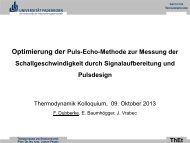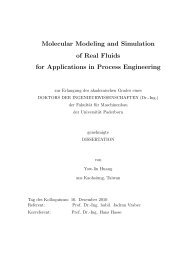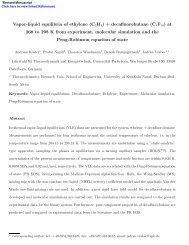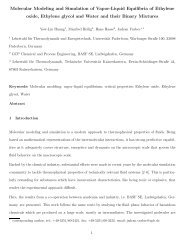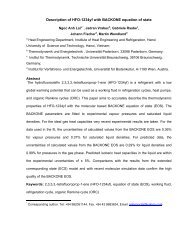ms2: A Molecular Simulation Tool for Thermodynamic Properties
ms2: A Molecular Simulation Tool for Thermodynamic Properties
ms2: A Molecular Simulation Tool for Thermodynamic Properties
Create successful ePaper yourself
Turn your PDF publications into a flip-book with our unique Google optimized e-Paper software.
−0.5 < x, y, z < 0.5. The advantage of this scaling scheme lies mainly in the efficient application of the<br />
periodic boundary condition [36] and the minimum image convention [37].<br />
The molecular orientations are stored using normalized quaternions [29]. Quaternions are a biunique representa-<br />
tion that avoid divergence problems at low angles. Their use allows <strong>for</strong> an efficient calculation of site positions,<br />
while being less demanding concerning execution time and memory than updating and storing all site positions.<br />
4.4. Initial configuration<br />
It is important to define a stable and physically reasonable starting configuration <strong>for</strong> a simulation in a reliable<br />
way. In<strong>ms2</strong>, the molecules are initially placed on a face-centered cubic lattice in order to avoid overlaps between<br />
molecules. For mixtures, the positions of the different molecule species are distributed randomly on the lattice,<br />
ensuring a homogeneous distribution of all components in the simulation volume.<br />
After the initial molecule placement, the configuration can be relaxed by translational and rotational MC moves.<br />
This step is part of the initialization process and can there<strong>for</strong>e be per<strong>for</strong>med regardless of the simulation technique<br />
used. The number of relaxation moves is user defined and should be chosen large enough to achieve a physically<br />
reasonable starting configuration. For MD, the molecules are subsequently assigned with initial velocities such<br />
that the temperature is specified and no net translational and rotational moment is present. It is recommended<br />
to continue with a MD equilibration until a physically reasonable configuration and distribution of velocities<br />
is achieved. The MC loops relax possible overlaps in the initial configuration, whereas the MD equilibration<br />
drives the system into a physically reasonable dynamic microstate. Note that the equilibration process does not<br />
contribute to the calculation of the thermodynamic properties.<br />
4.5. Intermolecular interactions<br />
4.5.1. Dispersive and repulsive interactions<br />
In <strong>ms2</strong>, the dispersive and repulsive interactions between molecules are reduced to pairwise interactionsu LJ<br />
ij of<br />
the different molecule sitesiandj, which are modeled by the 12-6-LJ potential [49]<br />
u LJ<br />
ij = 4ε σ 12 σ 6 − . (13)<br />
rij rij<br />
Here, the site-site distance between two interacting LJ sitesiandj is denoted byrij, whileσ andεare the LJ size<br />
and energy parameters, respectively. The LJ potential is widely used and allows <strong>for</strong> a fast computation of these<br />
basic interactions. It has only two parameters, which facilitates the parameterization of molecular models.<br />
For pure components, the interactions between two different LJ sites are described by the Lorentz-Berthelot<br />
combination rules [50, 51]. For mixtures, the combination rules are extended to the modified Lorentz-Berthelot<br />
rules, which include two additional parameters η and ξ to describe the interactions between LJ sites of unlike<br />
molecules [52]<br />
σij = η σi +σj<br />
2<br />
, (14)<br />
εij = ξ √ εiεj . (15)<br />
13



